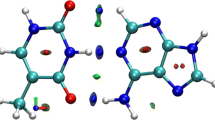Abstract
We reformulate and discuss a previously proposed variational numerical technique for the computation of dispersion coefficients. The method extends the Full CI idea to the perturbation equation for the intermolecular interaction, by expanding the perturbative solution in a small number of tensor products of suitably chosen Full CI vectors. Some new expansion vectors are proposed and their convergence properties are tested by performing computations on HF and H2O. Last, a natural state analysis of the solution is performed via an orthogonal transformation of the original expansion vectors and it is found that a single couple of natural states strongly dominates the expansion.
Access this article
We’re sorry, something doesn't seem to be working properly.
Please try refreshing the page. If that doesn't work, please contact support so we can address the problem.
Similar content being viewed by others
References
London F, Physik Z (1930) Chem Abstr B 11:222–251
Eisenschitz R, London F, Physik Z (1930) Chem Abstr B 60:491
Stone AJ (2002) The theory of intermolecular forces. Clarendon Press, Oxford
Magnasco V, McWeeny R (1991) Theoretical models of chemical bonding, Part 4. In: Maksic ZB (ed) Springer, Berlin, pp 133–169
Amos RD, Handy NC, Knowles PJ, Rice JE, Stone AJ (1985) J Phys Chem 98:2186–2192
Rijks W, Wormer PES (1988) J Chem Phys 88:5704–5714
Bendazzoli GL, Evangelisti S (2001) Adv in Quantum Chem 39:189–207
Langhoff PW, Karplus M (1970) The Padé approximants in theoretical physics. In: Baker GA, Gammel JL (eds) Chap 2. Academic Press, New York
Figari G, Magnasco V (2003) Chem Phys Lett 374:527–533
Bendazzoli GL (2005) Int J Quantam Chem 104:38–51
Rossi E, Bendazzoli GL, Evangelisti S, Maynau D (1999) Chem Phys Lett 310:530–536
Li JR, White J (2004) SIAM Rev 46:693–713
Robinson PD (1969) J Phys A 2:193–199
Monari A, Bendazzoli GL, Evangelisti S, Angeli C, Ben Amor N, Borini S, Maynau D, Rossi E (2007) J Chem Theory Comput 3:477–485
Bendazzoli GL, Monari A, Figari G, Rui M, Costa C, Magnasco V (2008) Chem Phys Lett 450:396–399
Bendazzoli GL (2007) Theor Chem Acc 118:135–142
Benkova Z, Sadlej AJ, Oakes RE, Bell SE (2005) J Comput Chem 26:145–153
Rijks W, Wormer PES (1989) J Chem Phys 90:6507–6519
Wormer PES, Hettema H (1992) J Chem Phys 97:5592–5606
Osinga VP, van Gisbergen SJA, Sniders JG, Baerends EJ (1997) J Chem Phys 106:5091–5101
Kutzelnigg W, Maeder F (1978) Chem Phys 32:451–455
Maeder F, Kutzelnigg W (1978) Chem Phys 32:457–469
Kutzelnigg W, Maeder F (1978) Chem Phys 35:397–405
Maeder F, Kutzelnigg W (1979) Chem Phys 42:95–112
Penzl T (2000) Syst Control Lett 40:139–144
Acknowledgments
Financial support from the University of Bologna and the italian Ministry of University and Research under the project “PRIN 2006, Molecular Quantum Mechanics: Computational Methods and Analysis of Novel Phenomena" is gratefully acknowledged.
Author information
Authors and Affiliations
Corresponding author
Additional information
Dedicated to the memory of Professor Oriano Salvetti and published as part of the Salvetti Memorial Issue.
Appendices
Appendix 1
Strictly speaking, Eq. 1 has an infinity of solutions, since to any given solution Φ AB1ab we can add products of the type Φ A0 f B and g A Φ B0 , where f B and g A are arbitrary functions, and get another solution. The dispersion solution is characterized by a kind of strong orthogonality to the ground state eigenvectors of molecule A and B, as clearly shown by the London sum-over-states representation given in Eq. 2:
Equivalently, we can define Φ AB1ab to be the solution of minimal norm of Eq. 1. As far as Eq. 11 is concerned, one has the conditions:
where v A0 , v B0 are the Full CI ground state eigenvectors of molecule A, B, respectively, and 0 A, 0 B are zero vectors. Consequently, the expansion vectors should fulfill the orthogonality requirements:
Appendix 2
For reader’s convenience we report here the explicit formulae used to compute the dispersion coefficients from the cartesian matrix elements:
in the notation defined by Eq. 5.
Rights and permissions
About this article
Cite this article
Bendazzoli, G.L., Monari, A. & Evangelisti, S. A numerical method for computing dispersion constants. Theor Chem Acc 123, 265–272 (2009). https://doi.org/10.1007/s00214-009-0520-5
Received:
Accepted:
Published:
Issue Date:
DOI: https://doi.org/10.1007/s00214-009-0520-5




